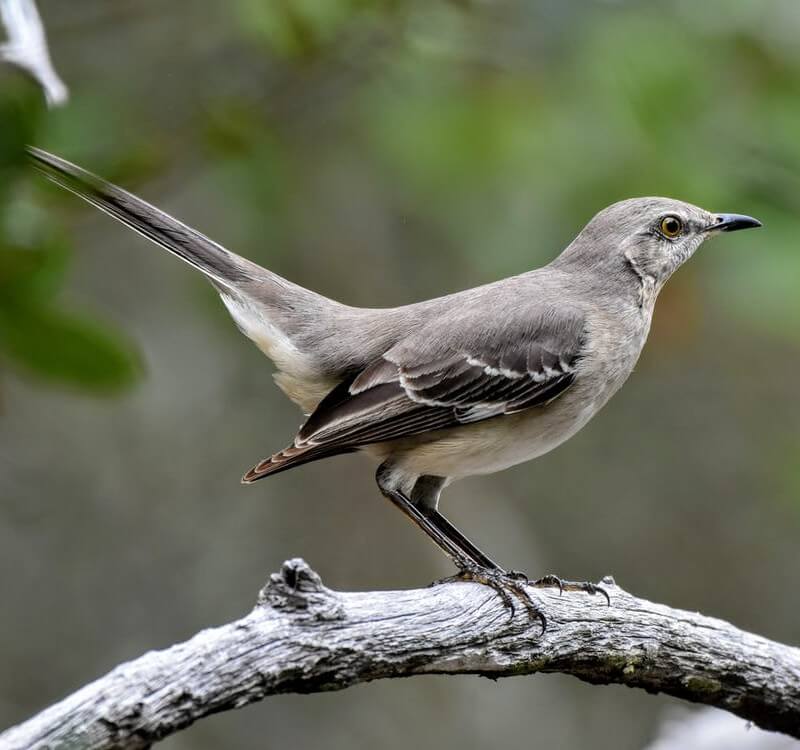From Tallahassee to Miami, the Sunshine State is home to some incredible birds. With 544 species observed on ebird, Florida’s warm climate and vast geography provide for an amazing habitat. In this post we’ll review 30 of the most common and colorful birds in Florida along with some helpful data on when and where to find them.
We even sampled 5 years of aggregate data from ebird’s Florida checklists to compile easy-to-use statistics and graphs to help identify each bird species. So whether you’re just watching the backyard bird feeder or venturing to birding hotspots like Fort De Soto Park or Lake Apopka – we’ll have you ready to start bird watching like a professional. But enough chirping, let’s get to it!
American Goldfinch
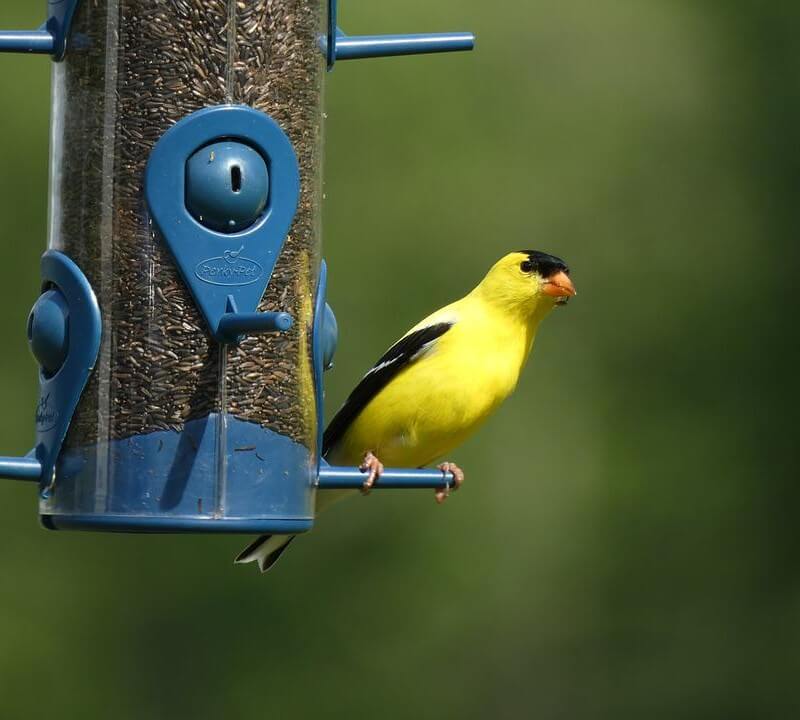
A small finch with a short tail, the American Goldfinch is widespread throughout North America.
- Carduelis tristis
- Size: 5″ (13cm)
- FL Checklist Frequency High: 8% in December
- FL Checklist Frequency Low: 0% in Winter
Identification and Color: A fan favorite at backyard feeders for its brilliant yellow color. A small, slim finch with a small bill and rounded wings. The back is black with white wing bars. Underparts are yellow with a black bill. The tail is white with black markings on the outer feathers.
Habitat and Behavior: The American Goldfinch nests and breeds in open woodlands, meadows, and fields. Commonly seen in gardens and parks. During the breeding season, the American Goldfinch is often seen in flocks. Known to hang upside down from branches while feeding. Typically nests late in the summer.
Diet: Strict vegetarian. The American Goldfinch feeds on tiny seeds, weeds and grasses. Enjoys nyjer and sunflower seeds. Rarely consumes insects.
American Robin
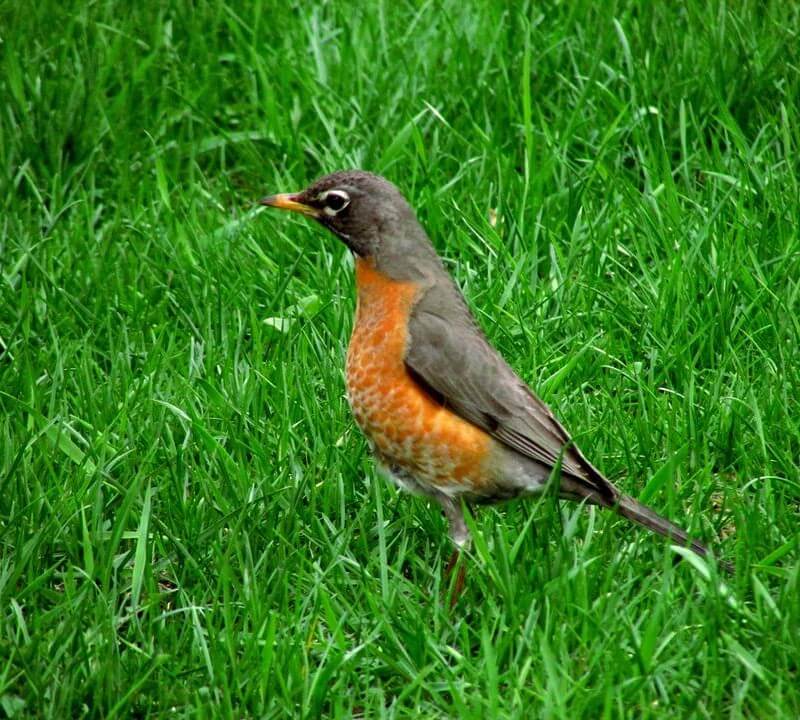
Abundant throughout the entire country and commonly a welcome indicator of spring in northern states. The American Robin is a common sight in Florida outside of the summer months.
- Turdus migratorius
- Size: 9-11″ (22.5-28cm)
- FL Checklist Frequency High: 18% in February
- FL Checklist Frequency Low: 1% in Summer
Identification and Color: Reddish-brown breast (almost looks pot-bellied) and grey back. The female usually has a lighter plumage than the male. Males have a darker black head.
Habitat and Behavior: The American Robin is found in open woodlands, gardens, and parks. It often forages for food on the ground cocking its head to the side in an effort to find worms. When it’s not eating, the American Robin can often be seen perched on a branch singing its cheerful song.
Diet: The American Robin feeds on insects, worms, berries, and fruits.
Belted Kingfisher

The Belted Kingfisher is a year-round resident of Florida’s coastline and waterways.
- Megaceryle alcyon
- Size: 13″ (33 cm)
- FL Checklist Frequency High: 24% in November
- FL Checklist Frequency Low: 1% in June
Identification and Color: These birds have bushy crests on their heads. Both males and females have blue-grey on their heads and their bodies are broken up with some white underparts. They also have a stripe in between their head and body. Females have a reddish brown part on their undersides. They have a thick pointed bill, short legs, and a large head.
Habitat and Behavior: Belted Kingfishers are common all over North America. Many will stay put in the United States for all seasons, and some fly very far south for winter. Will stay close to water such as streams or lakes. Spends most of the time alone overlooking the water for food.
Diet: The Belted Kingfisher mainly eats small fish but will also eat crayfish or frogs. May also eat some berries but only on a rare occasion.
Blue Jay

Blue Jays are one of the most recognizable birds in North America. Not one of the “nicest” birds, but a very common sight in Florida backyards year-round.
- Cyanocitta cristata
- Size: 11″ (28 cm)
- FL Checklist Frequency High: 58% in September
- FL Checklist Frequency Low: 26% in January
Identification and Color: Larger than a sparrow but smaller than a crow, with a characteristic blue plumage and white chest. Has a loud screeching call.
Habitat and Behavior: Blue Jays make their homes in woods and forests, but can also be found in urban areas. They are known for their loud calls, which can often be heard before the bird is seen. Blue Jays are not typically shy around humans and can often be attracted to backyard bird feeders. However, Blue Jays can be very aggressive towards other birds and animals so proceed with caution.
Diet: Blue Jays are omnivorous, meaning they will eat both plants and animals. Their diet includes acorns, nuts, seeds, fruits, and insects.
Blue-gray Gnatcatcher

The Blue-gray Gnatcatcher can be seen in Florida year-round.
- Polioptila caerulea
- Size: 4″ (10 cm)
- FL Checklist Frequency High: 48% in September
- FL Checklist Frequency Low: 10% in June
Identification and Color: A blue-grey color from the tops of their heads onto their backsides and white belly area. Their long tail feathers are black with white on the sides. A white ring around the eye is also present. During the breeding season, males will have a black line above their eyes.
Habitat and Behavior: The Blue-grey Gnatcatcher is found in many different locations. They will breed in the west and east and migrate or be permanent residents in southern areas. Prefers wooded areas of oaks or pines. An energetic bird that forages in surrounding trees or shrubs.
Diet: Insects including treehoppers, leaf beetles, and flies. May also eat some spiders.
Brown Thrasher
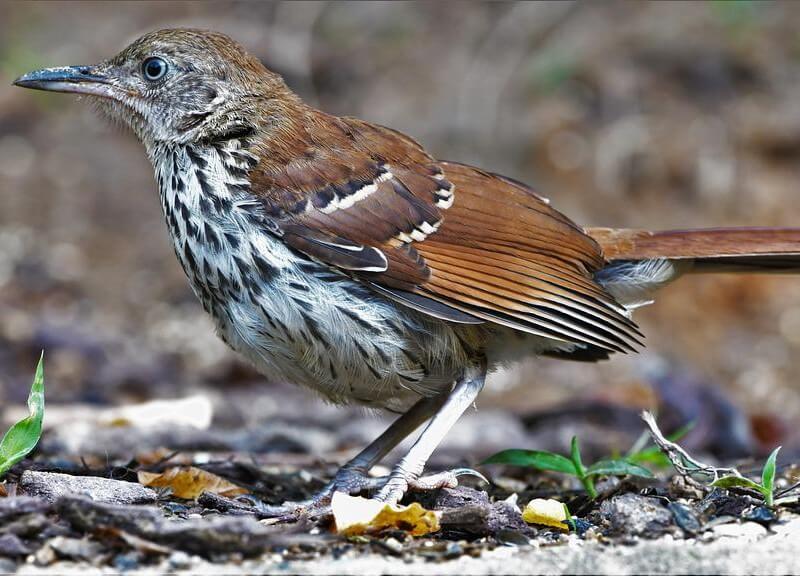
The Brown Thrasher is seen in Florida year-round.
- Toxostoma rufum
- Size: 11″ (28 cm)
- FL Checklist Frequency High: 14% in September
- FL Checklist Frequency Low: 2% in January
Identification and Color: From the tops of their heads to their backs they have a brown to reddish-brown coloring. A grey-brown patch on their face leads down to their underside which is also speckled with black. Have 2 wing bars of black and white and bright yellow eyes. They have a long tail, long legs, and long bill with a curve going downwards.
Habitat and Behavior: The Brown Thrasher is found throughout the midwest and east. The northern birds will often migrate to warmer climates but may stay depending on food source availability. Stays in thick areas of shrubs or trees. Will forage mainly on the ground.
Diet: Insects found on the ground will make up most of the diet, and berries, nuts, and seeds make up the rest.
Carolina Chickadee

The Carolina Chickadee is a year-round resident of Florida.
- Poecile carolinensis
- Size: 5.5″ (14 cm)
- FL Checklist Frequency High: 18% in September
- FL Checklist Frequency Low: 10% in December
Identification and Color: Their black-colored head is separated by white cheek patches. Darker grey wings and lighter grey to white underparts. A small and rounded bird with a thick but short bill. Both males and females will be around 4 inches in length.
Habitat and Behavior: The Carolina Chickadee is found all over a large portion of the southeast and is a permanent resident. Prefers to be in forested areas but can also be found around suburban locations. Can flock together but will usually eat separately. Forages mostly by hopping around on trees.
Diet: Variety of insects, seeds, and berries. Caterpillars make up the majority of the insects.
Carolina Wren
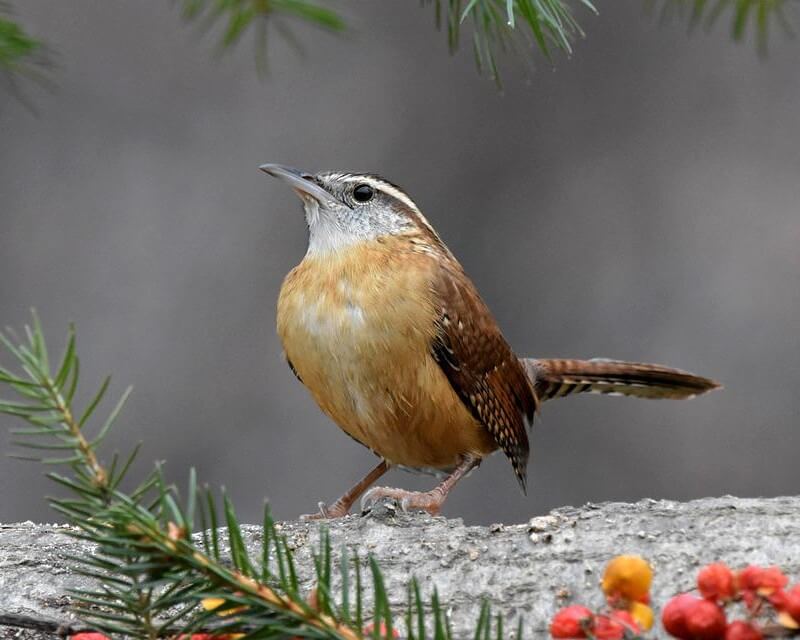
The Carolina Wren is a common bird in eastern North America that’s seen year-round in Florida.
- Thryothorus ludovicianus
- Size: 5.5″ (14 cm)
- FL Checklist Frequency High: 36% in September
- FL Checklist Frequency Low: 18% in January
Identification and Color: Small, slightly chunky with reddish-brown feathers and a rusty gold/yellowish belly. The Carolina wren is known for its loud, distinctive rollicking call.
Habitat and Behavior: Very curious and active, they are often seen moving around in low areas searching for food. These birds build their nests in trees or shrubs. Generally pretty tame but active in backyards.
Diet: The Carolina Wren diet consists mostly of insects and spiders from trees, but they will also eat fruit, berries, and seed.
Chipping Sparrow

The chipping sparrow is a small bird native to North America. Typically seen outside of the summer months in Florida.
- Spizella passerina
- Size: 5.5″ (14 cm)
- FL Checklist Frequency High: 9% in February
- FL Checklist Frequency Low: 0% in Summer
Identification and Color: Small and slender bird, measuring only about five and a half inches in length. Its body is brown and white, with a dark eye line extending from the beak past the eye.
Habitat and Behavior: The Chipping Sparrow can be found in open woodlands, suburbs, parks, farmland and backyards. Known to forage on the ground for seeds. Easy to mix up with other sparrows, the Chipping Sparrow loves open areas with scattered trees making it a common sight at feeders.
Diet: Primarily insects when available (mainly summer months). Enjoys finding seeds in the grass.
Common Grackle
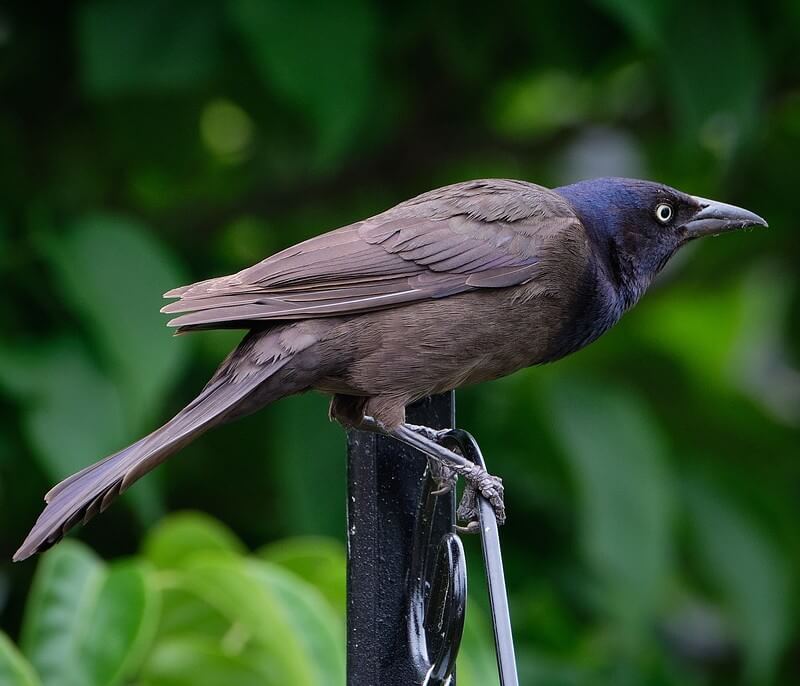
The Common Grackle is abundant throughout most of central and eastern North America. One of the most common backyard birds in Florida.
- Quiscalus quiscula
- Size: 12.5″ (32 cm)
- FL Checklist Frequency High: 31% in April
- FL Checklist Frequency Low: 17% in August
Identification and Color: Easily identified by their glossy black feathers and yellow eyes, the Common Grackle also has a curved beak. Female is a bit smaller and less shiny than the male.
Habitat and Behavior: Common grackles typically live in open areas such as fields and marshes. Usually forages in flocks. Very common in towns and cities. Known for being aggressive towards other birds.
Diet: The Common Grackles is omnivorous. Grains, seed, and insects are all favorites. Will also scavenge through garbage for food.
Common Yellowthroat

A small songbird commonly seen in Florida after the summer months.
- Geothlypis trichas
- Size: 5″ (13 cm)
- FL Checklist Frequency High: 22% in October
- FL Checklist Frequency Low: 2% in August
Identification and Color: Distinctive yellow throat patch and black mask. Pointy long thinned bill.
Habitat and Behavior: Often found in open woodlands and wetlands. The Common Yellowthroat is a fairly secretive bird, making it difficult to spot. However, the males are often heard singing their distinctive “witchity-witchity-witchity” song.
Diet: Variety of insects.
Eastern Bluebird

The Eastern Bluebird can be seen year-round in Florida.
- Sialia sialis
- Size: 7″ (18 cm)
- FL Checklist Frequency High: 13% in June
- FL Checklist Frequency Low: 8% in September
Identification and Color: Easily identified by its flashy blue plumage and rusty breast.
Habitat and Behavior: The eastern bluebird typically nests in tree cavities, but it will also use man-made nesting boxes. It is an active bird often seen perching on fences waiting to chase after insects.
Diet: Consists mainly of insects, but it will also eat berries and fruit.
Eastern Phoebe

The Eastern Phoebe is most often seen in Florida during the spring and fall months.
- Sayornis phoebe
- Size: 6″ (15 cm)
- FL Checklist Frequency High: 36% in November
- FL Checklist Frequency Low: 0% in Summer
Identification and Color: A dark grey to a black head and light grey top, wings, and tail. The underparts are a white to greyish color. In fall a pale yellow around the belly can be seen with some faint white on the wing’s edges. A plump, rounded-looking bird with a large head. They have a short, thin bill.
Habitat and Behavior: Located in the eastern half of the US and parts of Canada. They migrate early in the spring and late in the fall. Prefers open areas such as fields, forest edges, or riverside areas. Active birds that will perch low and frequently fly out to catch insects.
Diet: Insects such as bees, flies, and grasshoppers are all favorites. Will also eat some berries during the winter months.
Eastern Towhee

The Eastern Towhee is a year-round resident of Florida.
- Pipilo erythrophthalmus
- Size: 9″ (23 cm)
- FL Checklist Frequency High: 10% in June
- FL Checklist Frequency Low: 4% in November
Identification and Color: Males and females have reddish brown and white underparts with some white on their wings. However, males have a black top and females have brown on top. These birds will be between 6 and 9 inches in length. They have thick, triangular bills.
Habitat and Behavior: The Eastern Towhee is mainly found in the eastern half of the states. Northern birds will migrate and southern birds are permanent residents. Prefers undergrowth, thickets, and brushy areas. Mostly on the ground to forage but will also be in shrubs or low trees which is where you will most likely be able to see this bird.
Diet: Berries, seeds, and insects make up their diets. May also eat a small lizard or snake on occasion.
Gray Catbird

The Gray Catbird is a small songbird commonly seen in Florida outside of the summer months.
- Dumetella carolinensis
- Size: 8.5″ (22 cm)
- FL Checklist Frequency High: 47% in October
- FL Checklist Frequency Low: 0% in Summer
Identification and Color: A slender gray bird with a black cap and tail. Gray Catbirds are named for their call, which sounds like a cat meowing.
Habitat and Behavior: Gray Catbirds are found in wooded areas, often near streams or wetlands. Likes thickets and brushy shrubs. They are shy birds that do not often come into contact with humans. Gray Catbirds build cup-shaped nests out of leaves, twigs, and grasses.
Diet: Mainly insects in the spring and summer. Primarily berries and seed in the winter.
Great Crested Flycatcher

The Great Crested Flycatcher is a year-round resident of Florida.
- Myiarchus crinitus
- Size: 9″ (23 cm)
- FL Checklist Frequency High: 34% in April
- FL Checklist Frequency Low: 2% in December
Identification and Color: The Great Crested Flycatcher has a small, slightly raised crest atop their head. Brown-grey heads and top of bodies. Some red-brown in their wings and tails. A pale yellow underpart. A wide and straight bill that is black often with a lighter color at the base.
Habitat and Behavior: Spends the breeding and summer season in the eastern half of the United States. Will migrate to Mexico and farther south, some stay in the very southern part of Florida. Can be found in both dense forests and open woodlands. Will perch up high and wait for prey.
Diet: The Great Crested Flycatcher mainly eats insects like caterpillars, moths, and katydids. Will also eat some fruit and berries, mainly in their winter locations.
Killdeer

The Killdeer is commonly seen near the Florida coastline throughout the year.
- Charadrius vociferous
- Size: 10″ (25 cm)
- FL Checklist Frequency High: 13% in December
- FL Checklist Frequency Low: 5% in October
Identification and Color: Mostly brown on the head and top of the body. The head is marked with black and white patches. A white underpart with two black stripes across it. An orange tail part can be seen when in flight. The Killdeer has a long tail and long wings. A small and short bill.
Habitat and Behavior: Located throughout North America. Southern birds are mostly permanent residents and northern birds will migrate. Killdeer like to be in very open areas of lawns, fields, and coastline. Spends the majority of time on the ground running around.
Diet: Insects make up the bulk of their diet. Beetles, grasshoppers, and caterpillars are frequent favorites. They may also eat a small number of seeds.
Mourning Dove
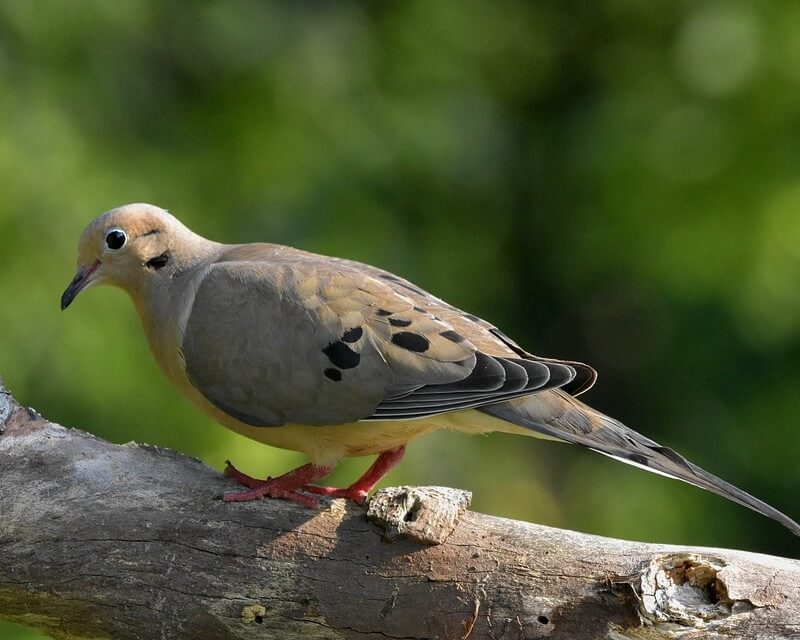
Mourning Doves are one of the most common birds in North America, and they can be found in a variety of habitats throughout Florida.
- Zenaida macroura
- Size: 12″ (30 cm)
- FL Checklist Frequency High: 55% in July
- FL Checklist Frequency Low: 32% in November
Identification and Color: These slender birds have long, pointed tails and a tiny head. Brown and pale gray plumage with darker streaks on the wings and back.
Habitat and Behavior: Mourning Doves are relatively quiet birds, but they can often be heard cooing softly. Mourning Doves typically nest in trees, but they will also use man-made structures such as window ledges and gutters.
Diet: The Mourning Dove primarily eat seeds, but they will also eat insects and berries
Northern Cardinal
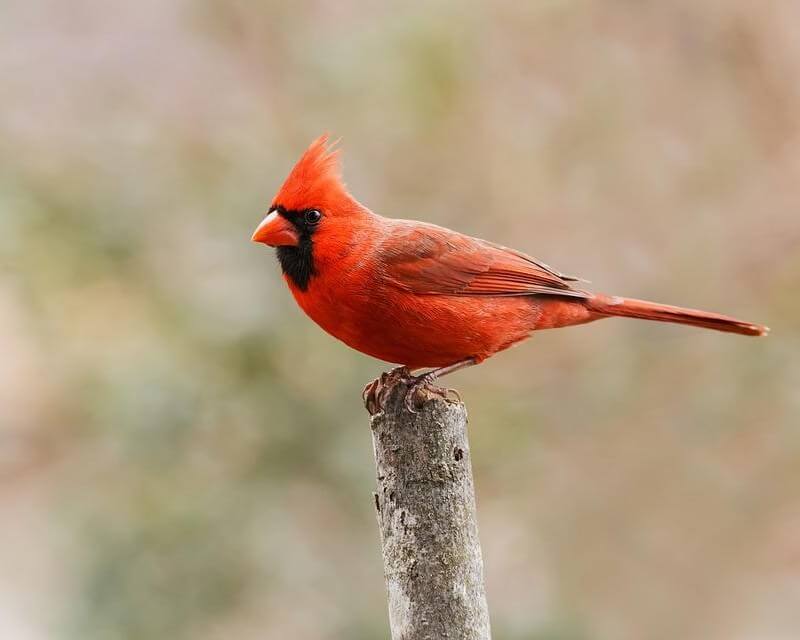
The Northern Cardinal is a beautiful red bird residing in Florida year-round.
- Cardinalis cardinalis
- Size: 9″ (22.5 cm)
- FL Checklist Frequency High: 64% in April
- FL Checklist Frequency Low: 33% in December
Identification and Color: A very common medium-size songbird with a pointed crest and long tail. Cardinals are easily identified by their bright red plumage, making them one of the most recognizable birds in North America. The Northern Cardinal is so popular it has been named the state bird by seven states – more than any other bird.
Habitat and Behavior: Cardinals are typically found near wooded areas but can be seen in a variety of places such as suburban backyards and parks. These birds are very social creatures, and they often form pairs that mate for life.
Diet: Northern Cardinals are up for anything and will visit most bird feeders. A rather varied diet that consists of insects, fruit, berries and seeds.
Northern Mockingbird

The Northern Mockingbird is the state bird of Florida. A common sight year-round known for its distinctive song and plumage.
- Mimus polyglottos
- Size: 10″ (25 cm)
- FL Checklist Frequency High: 55% in October
- FL Checklist Frequency Low: 32% in December
Identification and Color: Northern Mockingbirds are mostly gray in color with white patches on the wings and tail. They have a long black bill and yellow eyes.
Habitat and Behavior: Northern Mockingbirds are found in open habitats such as parks, woods edges, and suburban backyards. They are active throughout the day and are known for their territorial behavior, often chasing away other birds or small animals that come too close to their nest. The Northern Mockingbird is a bit of a joker with its constant imitating of other bird calls.
Diet: Northern Mockingbirds mainly eat insects, but will also eat fruits and berries in the winter.
Northern Parula
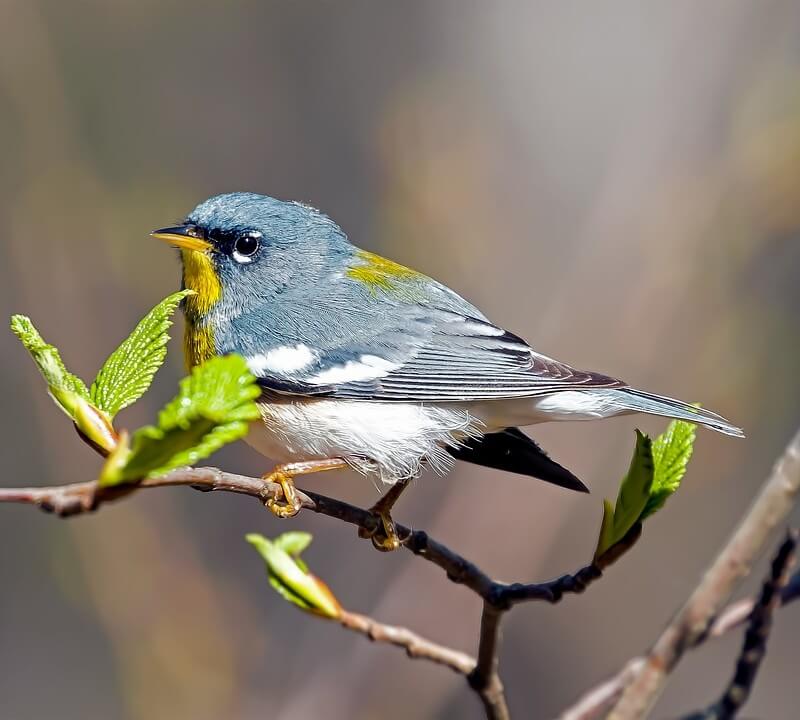
The Northern Parula is most often seen in Florida outside of the summer months.
- Setophaga americana
- Size: 4″ (10 cm)
- FL Checklist Frequency High: 32% in April
- FL Checklist Frequency Low: 3% in December
Identification and Color: Male Northern Parulas have a blueish-gray body with a yellow patch on their throat, front, and back of the body. A dark band separates the yellow patch of the throat and front. Females have paler colors and do not have that dark chest band in between the yellow. Both sexes have white marks above and below the eye that are not connected.
Habitat and Behavior: Generally breed and summer in the midwest and east and migrate far south during the winter. Prefer humid forests that are abundant in moss. Forages through trees and leaves.
Diet: The Northern Parula mainly consumes insects including beetles, flies, and moths. May also eat some small berries.
Palm Warbler
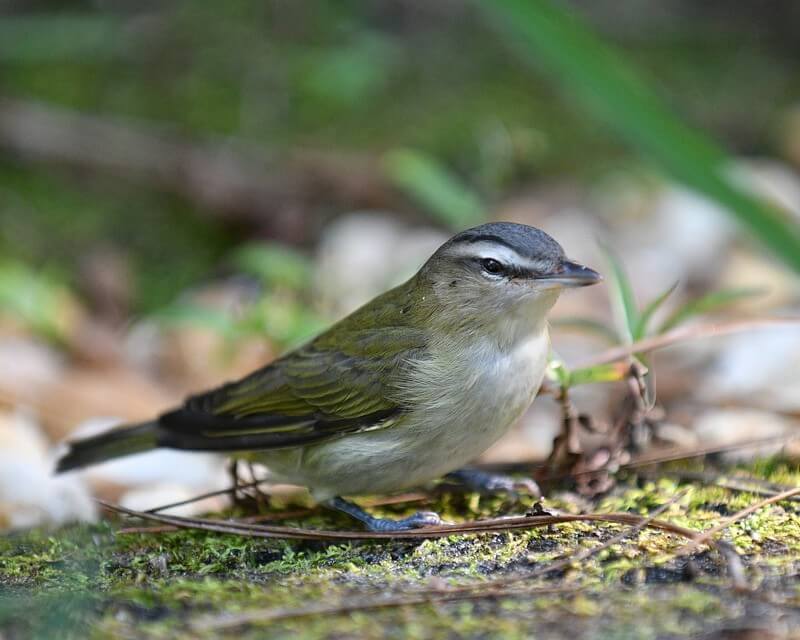
The Palm Warbler is a common sight in Florida outside of the summer months.
- Setophaga palmarum
- Size: 5″ ( 13cm)
- FL Checklist Frequency High: 50% in October
- FL Checklist Frequency Low: 0% in Summer
Identification and Color: The Palm Warbler has a reddish brown top on their heads. They have a brown to olive color on the top of their bodies with yellow underparts in the east. When found in the west, they have white underparts. A smaller bird that ranges about 4 to 5 inches in length. They have a narrow bill.
Habitat and Behavior: These birds will breed in the very far north and spend the winter in the very far south. Prefer to be in thick forests of evergreens and weedy fields. They are constantly moving their tail. Will forage mainly on the ground or in low areas.
Diet: The Palm Warbler will eat berries and insects. Will eat raspberries, bayberries, and seeds too.
Pileated Woodpecker

The Pileated Woodpecker is most often seen in Florida during the spring and fall months.
- Dryocopus pileatus
- Size: 15″ (38 cm)
- FL Checklist Frequency High: 24% in September
- FL Checklist Frequency Low: 12% in June
Identification and Color: These birds are mostly black with white stripes on their faces and necks. Both males and females have a brilliant red crest on their heads, but only males have a red stripe on their cheek. The Pileated Woodpecker is fairly large and has a long neck. They have a long and chisel-like bill.
Habitat and Behavior: Residents of the northeast and southeast mainly. They do not generally migrate. Favors anyplace with many trees, may be found at dead trees or even young trees depending on location. They forage by pecking into trees which is very loud.
Diet: The Pileated Woodpecker mainly eats the ants found in trees. They will also eat other insects, fruits, and nuts.
Pine Warbler

The Pine Warbler is typically seen in Florida during the spring and fall months.
- Setophaga pinus
- Size: 6″ ( 15cm)
- FL Checklist Frequency High: 14% in October
- FL Checklist Frequency Low: 2% in August
Identification and Color: The Pine Warbler is mostly yellow with darker coloring on their backs. Their wings are grey with two white bars on them. Males are much brighter than females. Both sexes have a faint eye ring of the same color on their heads. Long tails with a notch in the middle. They have stout bills.
Habitat and Behavior: Located throughout the eastern half of the US. Permanent residents of the south. Pine Warblers in northern locations will migrate. The Pine Warbler is fond of pine trees and will mostly be found in forests, spending the majority of the time high up in the trees. Will forage in trees or closer to the ground.
Diet: Their diet is largely insects but will also eat seeds and berries.
Red-bellied Woodpecker

The Red-bellied Woodpecker is a small to medium-sized woodpecker seen in Florida year-round.
- Melanerpes carolinus
- Size: 9″ (23 cm)
- FL Checklist Frequency High: 58% in October
- FL Checklist Frequency Low: 36% in January
Identification and Color: The Red-bellied woodpecker gets its name from the vaguely-visible reddish color on its belly, which is typically only seen when the bird is perched. They have a black and white striped back, white underparts, and a red nape.
Habitat and Behavior: The Red-bellied Woodpecker is a non-migratory bird, meaning it will stay in the same general area year-round. Forages for insects in trees or catches them in air. Can dominate other smaller woodpeckers and birds at feeders.
Diet: Consists mainly of insects and other invertebrates. Will also eat seeds, nuts and fruit.
Red-winged Blackbird

Mainly seen in the summer for most of the state. The Red-winged Blackbird is a year-round resident of Florida, especially near coastal areas.
- Agelaius phoeniceus
- Size: 8.5″ (22 cm)
- FL Checklist Frequency High: 27% in June
- FL Checklist Frequency Low: 9% in September
Identification and Color: A small black bird with a striking appearance. The male has black feathers and a red patch on each wing, while the female is mostly dark brown with vertical streaks.
Habitat and Behavior: These birds are found in open areas such as marshes, meadows, and fields. Often seen near water, where they build their nests. Red-winged Blackbirds are social birds and often form large flocks.
Diet: The Red-winged Blackbird diet consists of insects, spiders, and other small invertebrates. Will also eat seeds, fruits, and berries.
Ruby-throated Hummingbird

The Ruby-throated Hummingbird can be seen year-round in Florida.
- Archilochus colubris
- Size: 3.5″ (8 cm)
- FL Checklist Frequency High: 11% in September
- FL Checklist Frequency Low: 2% in Winter
Identification and Color: The Ruby-throated Hummingbird has a brilliant green color on the tops of their heads and bodies and a grey to white underpart. The males have a red throat that can appear dark in poor lighting. A small bird between 2 and 3.5 inches in length. They also have very short wings. A long, slender slightly curved bill.
Habitat and Behavior: In the summer they are found throughout the midwest and the eastern United States but almost all leave for the winter. The Ruby-throated Hummingbird prefers open woodlands, meadows, and gardens. They can fly very fast and will forage from flowers or feeders.
Diet: Mostly nectar from flowers but will eat some small insects.
Tufted Titmouse
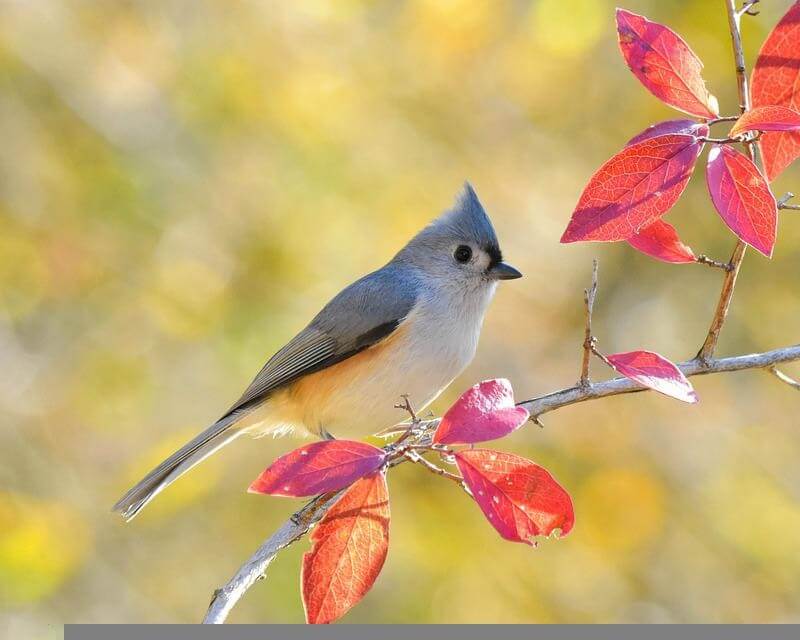
The Tufted Titmouse is a small songbird native to the eastern United States. Found year-round in Florida.
- Baeolophus bicolor
- Size: 6″ (15 cm)
- FL Checklist Frequency High: 29% in September
- FL Checklist Frequency Low: 14% in January
Identification and Color: A small songbird, adults have gray upper parts and whitish under parts. A distinctive tuft of black feathers on the head with dark eyes.
Habitat and Behavior: Tufted Titmice are non-migratory birds and can be found in woods, gardens, and parks. They are social birds that often form flocks with other titmice, chickadees, and nuthatches. Has a distinct “peter-peter-peter” call.
Diet: Likes to snag insects from bark or foliage. The Tufted Titmouse also consumes seeds, fruits, and berries.
White-eyed Vireo
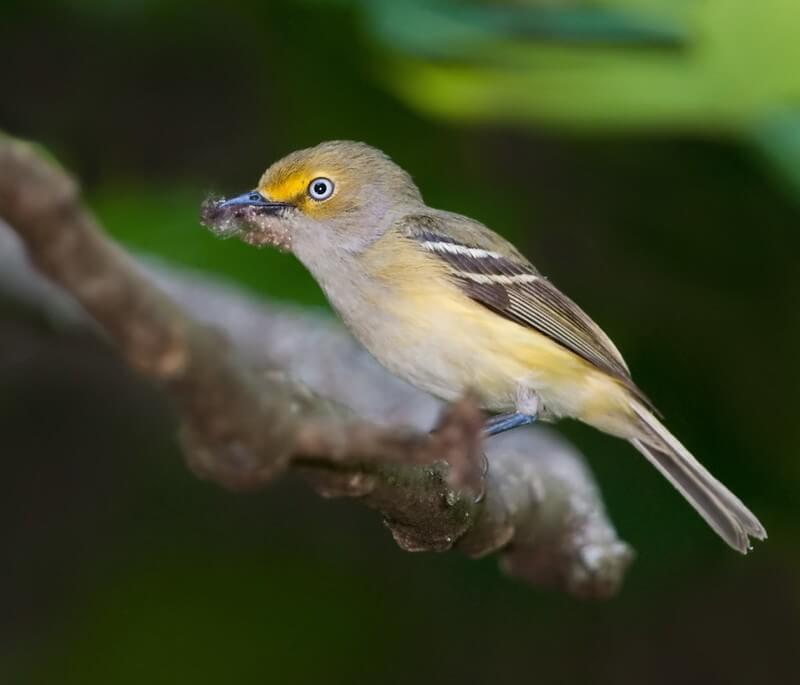
The White-eyed Vireo is common throughout the southeast and can be seen year-round in Florida.
- Vireo griseus
- Size: 5″ (13 cm)
- FL Checklist Frequency High: 25% in October
- FL Checklist Frequency Low: 6% in November
Identification and Color: The White-eyed Vireo is a small mainly yellow bird with white and black markings on its wing. Has a distinctive white ring in its eye. Long tail and a thin stout bill.
Habitat and Behavior: Typically seen near wood edges, areas of dense low shrubs, or swamp areas. Often seen in low areas of trees jumping from branch to branch looking for insects on leaves.
Diet: The White-eyed Vireo mainly feeds on insects and berries.
Yellow-rumped Warbler

The Yellow-rumped Warbler is most commonly seen in Florida during the spring and fall.
- Dendroica coronata
- Size: 6″ (15 cm)
- FL Checklist Frequency High: 41% in February
- FL Checklist Frequency Low: 0% in Summer
Identification and Color: A small warbler with a soft song, all Yellow-rumped Warblers have a patch of yellow on their sides and rump (hence the name).
Habitat and Behavior: The Yellow-rumped Warbler is typically seen in large flocks during migration in the spring and fall. Enjoys larger open wooded areas as well as brush and thickets. Most often found in trees bearing needles and cones.
Diet: Enjoys insects and berries. Difficult to attract to feeders.
Conclusion
In conclusion, Florida is home to a wide variety of backyard birds that can provide hours of entertainment and enjoyment for birdwatchers. From the colorful cardinal to the majestic belted kingfisher, Florida has something for everyone. With a little bit of research and patience, anyone can enjoy the beauty of these birds in their own backyard. Be sure to check out our other articles about birds in Florida:
Remember to keep that feeder full and have your checklist ready! Before you go, take a moment to review some of our favorite Florida birding resources:
